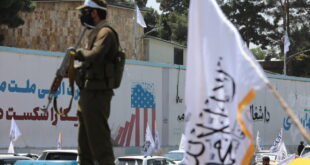It’s both good and bad news. The good part is pullout of US troops from Afghanistan which commenced on May 1 is going as per plan and putting an end its two-decade old “forever war.” The bad news is that just within 96 hours after this withdrawal commenced, Taliban carried out more than 100 attacks on Afghan security forces and government installations in 26 of the 34 provinces of Afghanistan. The most important gain that the Taliban has made thus far is seizing control of Burka district in the Baghlan province of North-Eastern Afghanistan on May 4 and Baghlan police spokesperson Ahmad Jaweed Basharat confirmed “that the enemy [Taliban] has captured the Burka district as a result of an encounter.”
While loss of Burka district is a major blow to Kabul, what is even more unnerving are the circumstances under which this district fell into Taliban hands. While Baghlan police spokesperson claimed that this was because “security and defense forces tactically, without suffering any losses, withdrew” from this area and spoke about “plans to recapture it,” Newsweek reported that this happened “after 200 government troops surrendered.” So, whether we believe Taliban or the police spokesperson, one thing is evident- Afghan security forces in Burka district didn’t put up a determined fight.
Readers may recall that while Taliban ceased attacking US troops after signing the February 29, 2021 peace treaty with Washington, it continued attacking government forces, further emboldened by lack of intervention from Washington. So, further escalation in Taliban attacks against Afghan security forces once US troops commenced their withdrawal was expected all along. It’s likely that those defending Burka district may have been vastly outnumbered and thus surrendered, but even if this was so, it still casts serious doubts on professional acumen of Afghan army leadership, which failed to discern the obvious.
Failure of Afghan army leadership to take pre-emptive measures and thwart Taliban’s designs by either increasing strength of troops in Burka district or drawing up contingency plans to counter the expected Taliban onslaught through standoff interdiction is a serious failing. The loss of Burka is undoubtedly the cumulative result of pedestrian leadership and lack of motivation within rank and file of Afghan security forces. This doesn’t inspire much confidence regarding Afghan army’s ability to keep Taliban at bay.
Foundation for Defense of Democracies Long War Journal, a renowned US news website reporting the war on terror, has determined that in the beginning of 2021, while the Ashraf Ghani government was in control controlled of 33 percent of Afghanistan’s districts, 19 percent were controlled by Taliban. Therefore, while the fall of Burka district may not be a catastrophic development in terms of territorial loss, it is nevertheless disconcerting as it is an unambiguous signal that rather than relying on the democratic process and becoming a co-player in future scheme of things through consensus, Taliban would instead use brute force to impose its exclusive writ over Afghanistan.
The Taliban’s utter disdain for the Ashraf Ghani government is evident from its statement issued on August 15 last year that “The Islamic Emirate [Taliban] does not recognize the Kabul administration as a government but views it as western imported structure working for the continuation of American occupation.” Accordingly,it’s unlikely that Taliban would sit and talk with what it considers to be a ‘puppet’ government. Furthermore, even if ‘Quetta Shura’, [Taliban’s supreme decision-making body] takes an accommodative stance, its frontline commanders combating Afghan security forces will definitely oppose any concessions being made to Kabul as it would be tantamount to mocking sacrifices of their dead fighters as well as squandering Taliban’s far superior fighting capability.
President Biden may believe that Taliban would honour its peace deal commitments by not allowing “any of its members, other individuals or groups, including Al-Qaida, to use the soil of Afghanistan to threaten the security of the United States and its allies.” However, when Taliban hasn’t even bothered to move an inch forward as regards working on “a permanent and comprehensive ceasefire” through “intra-Afghan dialogue and negotiations,” as specifically mentioned in Part 4 of the peace agreement, to expect it to abandon its close ally, Al Qaida [AQ], may be wishful thinking, and there are good reasons to believe so.
Despite having committed not to allow AQ use of areas under its control, this group’s number-two in the Indian subcontinent Abu Muhsin al-Masri [who was also on FBI’s ‘Most Wanted Terrorists list’] was killed by Afghanistan’s National Directorate of Security killed in Taliban controlled Ghazni province in October last year. The very next month, Afghan security forces gunned down yet another AQ terrorist of Pakistani nationality named Mohammad Hanif in Taliban controlled Western Afghanistan. The killing of two key AQ operatives in areas under Taliban control is a clear indication that Taliban has no intention of honouring the US-Taliban peace agreement!
The way events are unfolding in Afghanistan gives one an eerie feeling because Taliban continues to maintain its fundamentalist views and is determined to enforce its own convoluted brand of ‘Sharia’ [Islamic law]. So, while withdrawal of coalition forces from Afghanistan may be a cause for great celebration for the US and its allies, but for those in Afghanistan, the post-coalition force withdrawal scenario is foreboding as it will open the floodgates of death and destruction. Consequently, while the entire countryside will burn as Taliban and government forces battle it out for control of hamlets, villages and districts, imposition of Taliban brand ‘Sharia’ would take the country back to medieval times.
Those suspected of collaborating with the US or Afghan government will be publicly executed to set an example. Violation of Taliban’s diktats will attract public flogging and even execution, while hands and legs of petty thieves would be amputated while those accused of adultery would be stoned to death. Under Taliban rule, Afghanistan won’t have any working women as they would be confined to their homes, while girls’ schools will be permanently shut down. The May 8 bomb attack in front of Sayed Al-Shuhada school in Kabul, which killed at least 85 and injured 147 [mostly school girls], reflects Taliban’s opposition to female education].
For Taliban, the bottom line is that the Ashraf Ghani government must go- not because it’s perceived as “a western imported structure” but also since it has cordial relations with New Delhi. Islamabad wants a more amiable dispensation in Kabul- and Taliban is the only contender that fits the bill. Islamabad’s eagerness to see ‘Quetta Shura’ at the helm of affairs in Afghanistan is but natural. After all, despite severe international criticism and immense pressure from Washington, Islamabad still provided a safe sanctuary to Taliban leaders and their family members ever since 2001 and now the time has come for Taliban to return the favour!
Tailpiece: Though officially titled ‘Agreement for Bringing Peace to Afghanistan,’ the 2020 US-Taliban has until now, failed to live up to its impressive designation, and if past and present trends are any indicators to go by, then it’s extremely unlikely that this agreement will ever achieve peace!
 Eurasia Press & News
Eurasia Press & News



